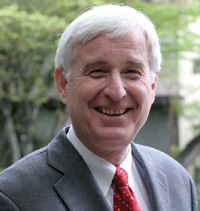Commentary: Fred Gilman
 Photo: Diana Rogers, SLAC |
Communication in challenging times
The question before the high-energy physics community in the United States at this moment is nothing less than whether we will continue to be among the world leaders in this field. To ensure a long-term future, we must start from the extraordinary science that lies ahead and our plan to explore that science. The High Energy Physics Advisory Panel (HEPAP) has an important role in communicating these scientific opportunities for 21st-century particle physics clearly and effectively.
At the HEPAP meeting in mid-February, there was intensive discussion of the tough priority choices necessitated by the constraints on funding in the federal budget proposal for fiscal year 2006. Even worse, the 2006 proposal is embedded in the context of a projected decline over the next five years of the budget of the primary supporter of the physical sciences, the Department of Energy's Office of Science. If anything like this projection is actually implemented, longstanding US leadership in many areas within the physical sciences will be lost.
This dire result is not set in stone. As a community we will do all that we can to make the case by communicating the significance and excitement of the scientific opportunities that are at hand, our prioritized plans for realizing the science, and what doing this science in the United States brings to the nation.
HEPAP is acting first in its traditional role of presenting advice from the scientific community to the Department of Energy and the National Science Foundation. In the past, HEPAP has dealt with many specific charges from the agencies and responded by forming a series of subpanels. Such a subpanel, chaired by Jonathan Bagger and Barry Barish, produced the twenty-year plan for our field in 2002. There are currently five HEPAP subpanels of this type; some are finishing up, others are just being formed.
In the last few years HEPAP has been asked to produce a different type of report, addressed to policy-makers who are not necessarily familiar with the detailed science of particle physics but who want to understand the central scientific questions that particle physics seeks to answer. In that vein, one of HEPAP's most important achievements of the past year has been the Quantum Universe report. It presents the revolutionary changes in particle physics at the beginning of the 21st century and the excitement of seeing how we will begin to answer the most compelling questions confronting our field. Quantum Universe was written for a broad audience and has been a tremendous hit, not only in this country, but abroad.
For high-energy physics, the science questions that would be answered by the International Linear Collider (ILC) are so compelling that the particle physics community worldwide has made the linear collider our top scientific priority after construction of the Large Hadron Collider (LHC) at CERN. This year has seen good progress toward an ILC with the choice of a single technology, and the choice of a leader, Barry Barish, for the Global Design Effort. In parallel with the efforts of the physics community, government representatives from Europe, Asia and North America--the FALC, or Funding Agencies for the Linear Collider--are holding discussions to try to understand how to make the ILC a global reality.
A new HEPAP subpanel is currently at work to produce a report in the style of Quantum Universe that defines and communicates the scientific questions that the ILC will answer in synergy with the LHC. In responding to the charge from the Department of Energy and National Science Foundation, the report will also answer clearly and convincingly the physics questions posed to HEPAP by the National Academies' decadal review of particle physics, EPP2010. The report of the EPP2010 panel, due late this year, is expected to have broad and significant influence on the future of US particle physics. The time is now to communicate the challenge and excitement of the science of 21st-century particle physics and the role that a vibrant US program can play.
Fred Gilman is Buhl Professor of Theoretical Physics and Head of the Department of Physics at Carnegie Mellon University. He is the current Chair of the High Energy Physics Advisory Panel (HEPAP).
Click here to download the pdf version of this article.


